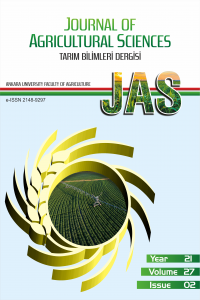Ankara’da Şeftali Ağaçlarında Görülen Sharka Hastalığı Üzerinde Araştırmalar
Plum pox potyvirus’un PPV sebep olduğu sharka hastalığı sert çekirdekli meyvelerin en tahripkar hastalığı olarak kabul edilmektedir. Bu hastalık yurdumuzda sınırlı bir dağılışa sahip olmasına karşın Ankara’da sert çekirdeklilerin en yaygın viral hastalığıdır. Sharka hastalığı kayısı ve eriklerde görülmesine rağmen son zamanlara kadar Ankara’da şeftalilerde görülmemiştir. Enzyme-linked immunosorbent assay ELISA ve Prunus persicae GF 305 şeftali çeşidine kabuk aşılama chip-budding yöntemlerine dayalı olarak Ankara’da 2002–2005 yılında yapılan bu çalışma ile PPP’nin şeftalilerdeki yaygınlığı ile belirtileri, strainleri ve çiçek organlarındaki bulunma durumu değerlendirilmiştir
Investigations on Sharka Disease on Peach Trees in Ankara
Sharka disease caused by Plum pox potyvirus PPV is considered to be the most devastating disease of stone fruit trees. This disease has a limited distribution in Turkey, and it is the most widespread viral disease of stone fruits in Ankara province. Until recently, sharka has not been observed on peach trees in Ankara, however, it was observed on apricots and plums. In this study which was carried out in Ankara in 2002-2005, the prevalence of the virus in peach trees, its symptoms, strains and presence in the generative tissues were evaluated. For this purpose, enzyme-linked immunosorbent assay ELISA techniques and chip-budding to Prunus persicae GF 305 peach seedlings were used
___
- Albrechtova, L. 1990. The detection of plum pox virus by ELISA in tissues of peaches during vegetation period. Zahradnictvi, 17: 251–262.
- Anonim 1968. EPPO/OEPP Bulletin, 1968. Rapport de la conférence internationale sur la sharka du prunier. Series A. No: 44.
- Azeri, T. 1994. Detection of virus diseases of stone fruits in Aegean Region of Türkiye. 9th Congress of the Mediterranean Phytopathological Union, Turkish Phytopathological Society Publications 7: 511-513.
- Blackman, R. L. and V. F. Eastop. 2000. Aphids on The World’s Crops: An Identification quide. Second Edition. A Wiley. Intenscience Publication.
- Brunt, A. A., K. Crabtree, M. J. Dallwitzitz, A. J. Gibbs and L. Watson. 1996. Viruses of plants. CAB International.
- Buchter, H., W. Hartmann und R. Stösser. 1987. Anatomisch histologische veränderungen bei scharkakranken trieben und wurzeln. Zeit. für Pflanzenkranheiten und Pflanzenschutz 94: 46-57.
- Cambra M., M. Asensio, M. T. Gorris, E. Perez, E. Camarasa, J. A. Garcia, J. J. Moja, D. Lopez-Abella, C. Vela and A. Sanz. 1994. Detection of plum pox potyvirus using monoclonal antibodies to structural and non-structural proteins. OEPP/EPPO Bulletin 24: 569-577.
- Clark M. F. and A. N. Adams. (1977): Characteristics of the microplate method of enzyme-linked immunosorbent assay for the detection of plant viruses. J. General Virology 34, 475-483.
- Conti, M., E. Loisoni e L. Giunchedi. 1985. La Sharka delle drupaceae estratto da l’Italia. Agricolo Anno 122, 22: 183- 193.
- Desvignes, J. C. 1999. Virus diseases of fruit trees. Èditions Centre Technique Interprofessionel des Fruits et Légumes, 202 pp.
- Dosba, F., M. Lansac, G. Pêcheur, B. Teyssier, J. P. Piquemal and M. Michel. 1986. Plum pox virus detection by ELISA technique in peach and apricot infected trees at different growing stage. Acta Horticulturae No. 193: 187–191.
- Dulic, I. and A. Saric. 1986. Outbreak of plum pox virus on peach in Yugoslavia. Acta Hort. 193:161-165.
- Elibüyük İ. Ö. ve G. Erdiller. 1991. Ankara ilinde kayısı, erik ve şeftali ağaçlarında görülen sharka hastalığının yayılış alanlarının tespiti ve tanısı üzerinde araştırmalar. VI. Türkiye Fitopatoloji Kongresi, Türkiye Fitopatoloji Derneği Yayınları No. 6: 411-415.
- Elibuyuk, İ. Ö. 2003. Natural Spread of Plum Pox Virus in Ankara, Turkey. J. Phytopathology 151 :617-619.
- Elibuyuk, İ. Ö. 2004. Current Situation of Sharka Disease in Ankara, Turkey. Phyoparasitica 32 :417-420.
- Gabova, M. 1994. Evaluation of peach and nectarine cultivars in Bulgaria for their resistance to plum pox potyvirus. EPPO Bull. 24: 755-760.
- Jordovic, M. and L. Janda. 1963. Morphological, anatomical and chemical changes on the fruits of some plum varieties infected by virus plum pox disease. Zast. Bilja 14: 653-670.
- Lopez-Moya J. J., M. R. Fernandez-Fernandez, M. Cambra and J. A. Garcia. 2000. Biotechnological aspects of plum pox virus. J. Biotech. 76: 121-136.
- Kurçman, S. 1973. Nachweis des scharka-virus an aprikosen und pflaumenbaumen in Ankara. J. Turkish Phytopathol. 2: 124- 129.
- Nemeth, M. 1986. Virus, mycoplasma and rickettsia diseases of fruit trees. Martinus Nijhoff/Dr. W. Junk Publishers.
- Polak, J. 1989. Diagnosis of Plum pox virus in infected symp- tomless trees of apricot, peach and Prunus cerasifera ssp. myrobalana by ELISA and ISEM. Acta Hort., 235: 299–303.
- Polak, J. 1995. Reliability of detection and relative concentration of Plum pox virus determinated by ELISA in an infected peach tree during the vegetation period. Z.Pfl.- Krankh. Pfl.- Schutz., 102: 16–22.
- Polak, J., I. Outropec, B. Krska, J. Pivalova and W. Miller.2003a. Difference in reactions of apricot and peach cultivars to Plum pox virus: serological and syptomatological evaluation. Hort. Sci. (Prague) 30: 129-134.
- Polak, J., J. Pivalova, W. Dowler and R. W. Miller. 2003b. Evaluation of American peach cultivars for resistance to Plum pox virus. Plant Protect. Sci. 39: 1-6.
- Sahtiyancı, S. 1969. Virus de la sharka chez le prunier. Bulletin Phytosanitaire FAO 17: 69.
- Varn, M. V., I. Mavric and M. Blazic. 2004. Influence of PPV infection on the yield and quality of different peach varieties. Lectures and papers presented at the 6th Slovenian Conference on Plant Protection, Zrece, 4-6 March 2003, 258-264.
- Yürektürk, M. 1984. Marmara bölgesinde sert çekirdekli meyvelerde görülen sharka hastalığı üzerinde araştırmalar. Atatürk Bahçe Kültürleri Araştırma Enstitüsü, 37 s.
- ISSN: 1300-7580
- Yayın Aralığı: Yılda 4 Sayı
- Başlangıç: 1995
- Yayıncı: Ankara Üniversitesi
Sayıdaki Diğer Makaleler
Gökçeada’da Ekstansif Koşullarda Hayvancılık Yapan İşletmelerin Sosyo-Ekonomik Açıdan İncelenmesi
Duygu AKTÜRK, Ferhan SAVRAN, Hakan HAKYEMEZ, Gürbüz DAŞ, Türker SAVAŞ
Altıngü PARLAK, L ö -, Zaslan -, Cafer S. SEVİMAY
Dengesiz Verilerle Çalışılması Durumunda Gruplardaki Gözlem Sayıları Kaç Olmalıdır?
Depolama Süresinin Bazı Hıyar Çeşitlerinde Mekanik Özelliklere Olan Etkisinin Belirlenmesi
Yeşim Benal YURTLU, Doğan ERDOĞAN
Sabahattin ALBAYRAK, Cafer Sırrı SEVİMAY
Nevzat AYDIN, H. Orhan BAYRAMOĞLU, Zeki MUT, Hasan ÖZCAN
Ankara’da Şeftali Ağaçlarında Görülen Sharka Hastalığı Üzerinde Araştırmalar
